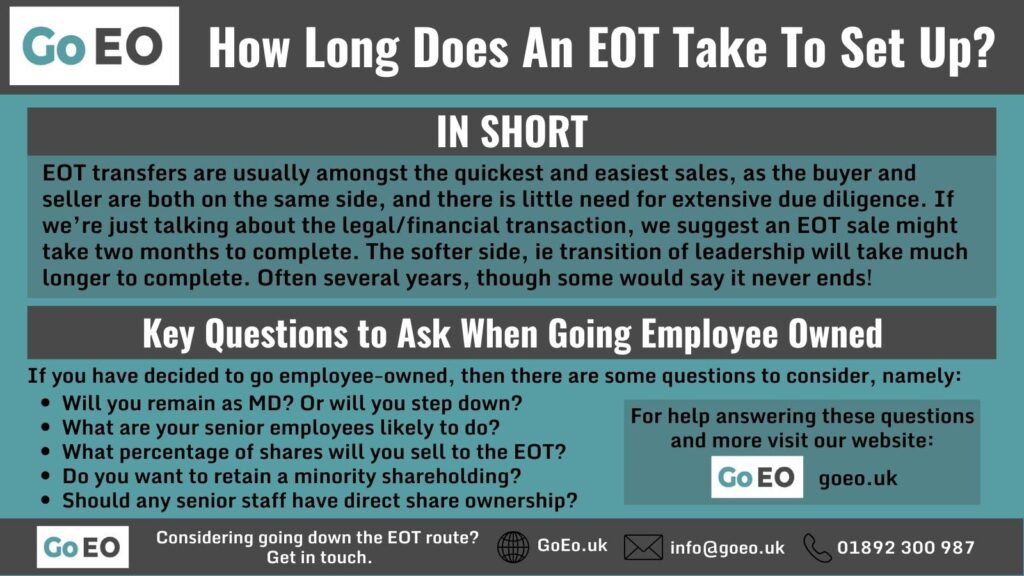If you have thought long and hard about it, and come to the conclusion that you want your business to become employee-owned, then it is only natural you will have a number of questions.
Some of these will most likely be about timescales, most notably you will probably want to know how long does an Employee Ownership Trust (EOT) take to set up?
Like any business sale, there are a number of boxes to tick before the transfer is complete, but unlike many business sales the buyer and seller are on the same side, which does make things easier.
So let’s take a closer look at how long it might take for an EOT transfer to go through.
How Long Does An EOT Take To Set Up?
EOT transfers are usually amongst the quickest and easiest sales, as the buyer and seller are both on the same side, and there is little need for extensive due diligence. If we’re just talking about the legal/financial transaction, we suggest an EOT sale might take two months to complete. The softer side, ie transition of leadership will take much longer to complete. Often several years, though some would say it never ends!
Becoming an EOT

Here at GoEO we specialise in helping small companies transfer ownership to EOTs, and we know that no two cases are ever the same.
Sometimes a transfer can go through within a few months, where the founder has all their ducks lined up. Other times it can take years, with the coaching of both the founder and senior team taking the lead as to what the EOT will really mean for them/their role.
EOT sales are often much quicker and easier than trade sales, and this is for the reason mentioned in the introduction, the buyer and seller are on the same side.
There is no independent party who doesn’t trust you and who wants to engage in lots of time-consuming due diligence.
But in contrast to a trade sale, time is needed to arrange an independent valuation of the company and to apply for clearance from the HMRC.
So if you are considering becoming an EOT, let’s look at the steps you will want to go through and how long you can reasonably expect it to take.
Going EO: The Steps You Need to Take
Before you legally start the process of selling your business to an EOT, you need to make sure that it is the right structure for you.
You might want to seek advice from a solicitor and/or accountant or contact us here at GoEO, where we can discuss the pros and cons of the EOT model and how it may work for you.
We would also strongly suggest liaising with, and becoming a member of, the Employee Ownership Association (EOA).
They are a not-for-profit organisation set up purely to assist employee-owned companies and those considering it.
You’ll want to consider what your role will be post-sale. Will you remain as MD? Will you step down? Perhaps you’ll gradually reduce your hours and role over a few years?
Following that, you’ll want to consider what your senior employees are likely to do. How will their skills and desires sit alongside what you want for yourself?
Before any sale is concluded it is extremely important to engage with management and employees and explain to them how the EOT will benefit them, and the role they will play in the company when it becomes an EOT.
You’ll also want to ensure the finances will broadly achieve what you want. Eg if this is part of a retirement plan, is the sale of the business likely to give you what you need? Or do you need to stick at it a few more years first, before selling?
Remember the payout often takes multiple years, and there’s also a risk if the business fails soon after sale, you may not get paid all of the sale proceeds agreed. You might also want to think about:
- Do you want to sell 100% of your shares to the EOT? The EOT must acquire a controlling stake (ie 51+%) to achieve most of the tax perks.
- Do you want to retain a minority shareholding?
- Should any senior staff have direct share ownership?
Once you’re happy it’s time to press ahead, and you will want to arrange for an independent valuation of the company to be conducted, as this will form the basis for any sale. Often the same advisor will also apply for tax clearance on your behalf.
During this period, there are a number of key things to consider whilst waiting for HMRC to grant tax clearance, namely:
- Confirming exactly what proportion of the company’s shares the EOT will acquire. It will need to be between 51% and 100% for the company to be considered employee owned.
- What will the payment structure be? Usually the seller is paid over a period of time, so how much will be paid and over what period?
- Who will be the trustees (legally the directors of the EOT company to be set up)?
- Will there be any changes to the management team of the trading company?
When the independent valuation of the company has been agreed, and tax clearance received, you’re then in a good position to press ahead.
Then it’s time to prepare the paperwork for the sale.
At this point you will be ready to set up the EOT through a trust deed.
When that has been set up, and numerous formal documents signed, the transaction will be complete. The EOT has now bought your shares. Legal title to the shares doesn’t formally change hands until the stamp duty sign-off is provided, but in practice, the sale can be considered complete from sign-off date.
Normally the purchase balance will be outstanding at this time and will be paid to the business founder over a set period of time according to the payment plan.
Let’s Talk Timescales

The legal transfer of the shares from the owner to the EOT happens in one day.
Obviously though, before you get to that point, there is a lot of preparation that needs to be done.
The actual process of setting up an EOT could be done in two months in an ideal case, but usually it will take longer than this.
And you will most likely spend a number of months, or even years, considering the prospect of becoming EO, before you formally start the process.
And then once the transfer to the EOT has taken place it doesn’t end there.
Naturally there is a culture change in the business.
The owner is no longer the owner and the staff will need to get used to the idea that it is their business and that they are represented by a staff trustee on the EOT.
Additionally, at this time, the business founder will most likely still be getting paid back gradually for selling their business to the EOT.
Depending upon the payment plan that has been agreed this could take anything from 0 to 10 years.
Many staff will be waiting for that magic moment of Financial Freedom Day, when the owner has been fully paid off!
After this, there is a greater share of cash for staff to enjoy in the form of profit share payments.
How Can Go EO Help?
If you are considering selling your business to an EOT, then get in touch with us a few months prior to your planned transfer date and we can help:
- Ensure you fully understand the EOT process.
- Prepare a valuation and payment plan.
- Submit a tax clearance request to the HMRC.
- Prepare legal documents.
- Submit relevant items to HMRC and Companies House.
- Provide ongoing support to help with the transition once the business has transferred to an EOT.
We try to offer simple, transparent costs and provide great value for money.
To find out more visit our Pricing page.
Or to find out more about transferring your company to an EOT, get in touch with us.
Summary
Setting up an EOT is usually fairly straightforward, and can take as little as two months in ideal circumstances.
However as the seller and the buyer are already familiar with the business, there will be little time spent on due diligence and preparing documents, especially compared to a trade sale.
However, in contrast, there is time needed to arrange for an independent valuation of the business and to apply for clearance from HMRC.
There will also be some time spent prior to formally beginning the process to ensure the EOT model is right for you.
After the transfer has been completed, there is a culture shift as the employees adjust to the new implications of being part of an employee-owned business.
And in addition to this, it can take a number of years for the business founder to be fully paid off.
But it remains that EOT sales are typically the quickest and easiest company sales!
If you are interested in finding out more about transitioning to an EOT, get in touch with us at Go EO to see how we can help.


